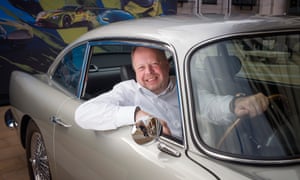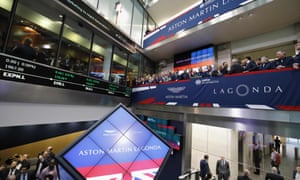Despite carmaker’s disappointing stock market debut, Andy Palmer says investors feel ‘pretty good’

Andy Palmer, the CEO of Aston Martin, says his hardest day at the luxury carmaker ‘was in 2015, when I had to make 400 people redundant’.
Photograph: Sarah Lee for the Guardian
Andy Palmer has written himself into the history books. The Aston Martin chief executive has done something this week that nobody has done for almost 30 years – float a car company on the London Stock Exchange.
It doesn’t sound like much. But UK investors are notoriously averse to the thrills and spills offered by car manufacturers, preferring the more esoteric world of outsourcers, service providers and financial firms.
Aston Martin Lagonda debuted on Wednesday at 1,900p, valuing the James Bond carmaker at £4.3bn. It sold 25% of the company’s shares just below the middle of its price range but the stock quickly hit the skids, closing at 1,810p by the end of the first day’s trading and slipping further, to 1,748 by Friday lunchtime.
In an upstairs room at the London Stock Exchange, immediately after the first dealings, Palmer looked tired but elated – probably just like a boss should look after dragging a loss-making carmaker back from the brink of extinction to the floor of the London Stock Exchange inside four years.
Aston has joined the market at a time when the rest of the British car industry is in meltdown over falling sales of diesel-powered vehicles – new car sales slumped 20% in September, according to new figures out this week – and the potential threat posed by Brexit.
The Midlands-based sports car manufacturer, however, appears to have bucked that trend. It has doubled production of its elegant vehicles to 7,000 a year and plans to double again to 14,000 by 2022. The confidence in Aston’s future prospects is rooted in a new factory, just outside Cardiff, which begins production of a new sports utility vehicle (SUV) early next year and will also be the base for its future electric vehicles.
Aston’s other big advantage, at the moment, is that its biggest markets are Britain, the US and China – just 25% of its annual production goes to the EU.
“We are still growing when the market is down,” he says. “Which is proof of how insulated we are.”
The float raised about £1bn for some of Aston’s owners – the Italian private equity fund Investindustrial, plus several Kuwaiti funds. Daimler, the German giant that supplies engines to Aston and owns 5% of the British carmaker, has held on to its stake.

“Investors still have 70%,” Palmer says. “They have taken some rewards; they are feeling pretty good right now. They are locked up for another six months but I don’t think they are in any rush. None of them are telling me: ‘Andy, we are out in six months.’”
Palmer stands to pocket around £24m from a four-year share-based incentive scheme.
Not bad for a working-class boy who grew up with his brother, who is five years younger, only four miles down the road from Aston’s base in Warwickshire. His father was an engineer, his mother a secretary.
Palmer also did his apprenticeship down the road at a car parts firm in Leamington Spa 38 years ago. That led to a job at Austin Rover, where he worked on upgrading the Mini and first encountered the jaw-dropping attention to detail that Honda brought to a joint venture.
From that moment, Palmer was hooked on Japanese industrial practice. So off he went to Nissan, where he spent 24 years, including a 13-year stint in Japan.
The 55-year-old doesn’t just talk the talk, though. He’s a bona fide “petrolhead”, who rides a BMW K1600 motorbike at weekends and races an Aston Martin Vantage GT4.
Palmer may not be feeling much Brexit anxiety but, before jumping into the Aston hot seat in October 2014, he was the number three executive at Nissan Group, so he recognises the strain it is placing on his fellow captains of industry.
A hard Brexit would result in British car manufacturers trading with EU countries on World Trade Organization rules. These WTO rules apply 4.5% tariffs to car parts and 10% to finished cars.
Analysis by the Society of Motor Manufacturers and Traders suggests that EU tariffs on cars alone could add at least an annual £2.7bn to imports and £1.8bn to exports. These import tariffs could push up the list price of cars imported to the UK from the continent by an average of £1,500.
It is a stark prospect for Britain’s car-buying public, who are drawn to the badges of the big European players such as Volkswagen, Mercedes and BMW.
A staggering 80% of the UK’s car production is exported, of which 54% goes to EU member states. However, Britain imported 2.3m vehicles from other EU countries last year – almost three times the number sent the other way.
Nissan, Toyota, Honda, Ford, BMW, Jaguar Land Rover and PSA Group, which owns Vauxhall, have all warned that a no-deal Brexit could have dire consequences for the future of their UK car factories.
“That’s the rhetoric you are hearing from the industry,” Palmer noted. But the outlook is not great, he says, for European producers either. “We have to be pragmatic about Brexit,” Palmer says. “It’s obviously not great but it’s not great for either side of the Channel. You know you are going to lose market share [because of higher pricing].
“In the industry, the UK is known as ‘treasure island’ because it’s usually one of the most profitable markets. Why? Because we like cars, so we usually upscale.

“Suddenly, [post Brexit] that market becomes expensive … It’s just bad news because, for most of these guys, the UK represents 20% of sales and probably more of their profits.”
By 3pm on Wednesday afternoon, Aston’s share price began to rally. Palmer’s spirits, like the stock, lifted momentarily. “That’s America waking up. Look, it’s the first day, so you can’t judge it based on one day,” he says of the early price fall.
“We wanted to fill the book with long-only investors and not just go for the quick return.”
The share price is now around a level that reflects the earnings multiple (about 21 times) applied to New York-listed Ferrari, the other listed luxury car brand.
Putting the Aston Martin brand alongside the more globally recognised Ferrari name is rewarding work for Palmer. It has been a long, hard road to get there, however.
“The hardest day was in 2015, when I had to make 400 people redundant. That was the shittiest day,” he says. “The cost base was out of control and the management structure was upside down – we had too many managers. We went down to 1,800 people; now we have more than 3,000. By 2022, we will have 5,000.”
Palmer’s surgical approach may have been tough but he had few options. When he took the wheel at Aston the business was loss-making and there were huge concerns about its future.
In 2015 and 2016, the marque made total losses of £291m. After the difficult cost cuts and debt refinancing was done, the business rallied. Last year it clocked up a full-year profit of £84.5m and it has made further progress this year with a small increase in first-half pre-tax profit to £20.8m.
“It was painful,” Palmer says. “The other hard thing was to change the company culture. It was cowering, like a beaten dog. I wanted to get a bit of the swagger back.”
That now seems a distant memory for Palmer. The Aston boss reckons the luxury carmaker is no longer a cowering dog: “Aston Martin has got its mojo back,” he says. “It’s great.”